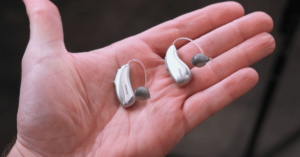Inflammatory arthritis is less common than osteoarthritis, but is still a common condition affecting many people around the world today. While arthritis may seem to be far removed from the auditory system and thereby unaffected by or unrelated to hearing loss, inflammatory arthritis and hearing loss may actually be related. After all, the entire body is related; when one part is harmed, damaged, or no longer working efficiently, all parts can be affected, and the same is true of inflammatory arthritis and the auditory system. How are the two connected? We’ll dive into that in greater detail below to determine whether or not inflammatory arthritis can be at the root of hearing loss.
What Is Inflammatory Arthritis?
Inflammatory arthritis is a form of autoimmune disease. Autoimmune diseases occur when the body’s immune system attacks itself–in this case, it’s tissues and joints. In inflammatory arthritis, the result is stiffness and pain in the joints and, oftentimes, joint damage. Joint damage can be so severe that it results in deformity of the joint, which is irreversible and can actually change the shape of the joint.
Typically, inflammatory arthritis is considered a systemic autoimmune disease, because it can affect the entire body, rather than being localized to a single spot. The most common types of inflammatory arthritis include rheumatoid arthritis, psoriatic arthritis, and ankylosing spondylitis.
Rheumatoid Arthritis
The first of the systemic autoimmune disorders identified above, rheumatoid arthritis, also called RA, is likely the most well-known type of autoimmune arthritis.
What Is Rheumatoid Arthritis (RA)?

Rheumatoid arthritis is an autoimmune disorder wherein the body attacks the joint tissues, resulting in inflammation and swelling around the joints in the body. It is a form of inflammatory arthritis, and rheumatoid arthritis patients can experience swelling, pain, and discomfort in many joints at once, though the joints most commonly affected include the hands, wrists, and knees. It can also affect other tissues throughout the body and impair heart, lung, visual, and hearing function. This is one of many factors affecting hearing levels in individuals with autoimmune disorders.
How Does Rheumatoid Arthritis Affect Hearing?
As a form of inflammatory arthritis and an autoimmune disease, rheumatoid arthritis puts patients at a greater risk for autoimmune inner ear disease, which can result in hearing loss. Hearing impairment has been reported in patients with an autoimmune disease, including rheumatoid arthritis, but the reported prevalence of hearing loss within persons with RA varies widely. However, sensorineural hearing loss is the most commonly reported hearing loss within this patient population, with up to 80% of RA cases showing some degree of SNHL. Conductive hearing loss and mixed hearing loss have been reported as well, although much less frequently.
Psoriatic Arthritis

Although many people are familiar with psoriasis, they may not be as well versed in the inflammatory arthritis known as psoriatic arthritis, or PA. Unlike psoriasis, which only affects the skin, this form of inflammatory arthritis affects the joints and other areas in the body.
What Is Psoriatic Arthritis?
Similar to rheumatoid arthritis, this form of arthritis also involves the joints, with the addition of skin rashes and pitted, large nails. Unlike rheumatoid arthritis which is typically found in the hands and wrists, PA rashes and joint inflammation are primarily in the hands and feet, and generally do not impact common sources of pain such as the knees.
How Does This Type Of Arthritis Affect Hearing?
The type of ear involvement typically seen in psoriatic arthritis is one of the ways that it is differentiated from rheumatoid arthritis. Patients with PA may be more likely than rheumatoid arthritis patients to report hearing impairment alongside vestibular issues and balance impairments. Altogether, this means that the hearing impairment or loss experienced from PA is likely to involve the inner ear and diseases involving that region. In one study, findings demonstrated that over half of the patients involved in the study showed high-frequency sensorineural hearing loss, with as much as a quarter of their subjects showing abnormal vestibular findings. In another study, there was a significant correlation between PA and sensorineural hearing loss.
Symptoms Of Hearing Loss

Hearing loss can occur over time, and may begin situationally rather than starting all at once. Sudden hearing loss or hearing impairment is possible, but is less common and far less likely. The most common signs of hearing impairment include:
- Muffled speech and other sounds often described as hearing “underwater” or distantly.
- Difficulty understanding words, particularly in crowded or noisy places.
- Trouble with clarity of speech, especially regarding consonants.
- Frequently feeling the need to ask others to repeat themselves.
- Frequently feeling as though others are speaking too quickly.
- Needing to turn the volume of the television up louder than is usually preferred.
- Increased avoidance of social groups and settings.
- Being bothered by background noises.
- Ringing in the ears or increased risk of tinnitus.
The symptoms of hearing loss, from sensorineural hearing loss to conductive hearing loss, typically follow a similar pattern. Mixed hearing loss, too, frequently comes with some degree of similarity of symptoms. This can make diagnosing difficult without a thorough medical history and self-reported symptoms; while the most common hearing impairment may be easy enough for a healthcare professional to identify, more complicated underlying causes and issues require a greater degree of investigation.
Causes Of Hearing Loss In Inflammatory Arthritis
Autoimmune inner ear disease is still being researched, and there is still much that remains unknown. Nevertheless, we know that autoimmune diseases occur when the body attacks itself. The risk for damage to the inner ear, middle ear, and even the auditory nerve, is possible and even likely when autoimmune inner ear disease and autoimmune hearing loss are present.
From damage to cochlear hair cells due to the loss of blood flow that occurs during inflammation, to damaged ossicles in the middle ear, patients with inflammatory arthritis continue to be at increased risk for developing hearing loss than those without a form of inflammatory arthritis. Sensorineural hearing loss, conductive hearing loss, and mixed hearing loss are all more likely for patients with rheumatoid arthritis and other inflammatory autoimmune diseases.
Evaluation And Treatment Of Hearing Loss
After visiting with your medical provider to address arthritis symptoms and autoimmune disease, it is typically a good idea to address any hearing impairment and balance symptoms you may also be experiencing. Medical attention is essential to address all aspects of inflammatory arthritis and the conditions that can come along with it. A visit to an audiologist or otolaryngologist (Ear, Nose, and Throat doctor) is typically recommended to address any issues of the middle ear and inner ear that may be contributing to hearing loss symptoms.
During your visit, a healthcare professional will take a medical case history and complete a comprehensive audiological evaluation to determine if your autoimmune inner ear disease has caused any lasting hearing impairment or peripheral loss of balance function. Typical test batteries include the following:

- Otoscopy
- During this exam, a small, magnified light is placed in the ear canal to visualize the ear canal and ear drum. This allows healthcare professionals to determine the health of the middle ear to rule out conditions involving this portion of the ear. If structures within the ear canal are damaged or unhealthy, doctors will have a clear view of the issue. An otoscopy is typically completed prior to being fitted for hearing aids, as well.
- Tympanometry
- This immittance test is used to evaluate the mobility of the middle ear system and any middle ear involvement in hearing loss. The test evaluates the ossicles (small middle ear bones) to rule out middle ear disorders that can cause conductive hearing loss. This is particularly useful when arthritis of the middle ear bones is suspected.
- Sound Booth Audiometry
- A pure tone audiometry hearing test involves inserting earphones into the ears or placing headphones on a patient’s ears. Pure tones are then played at different sound levels in short beeps. Patient responses are recorded by either pushing a button or raising a hand to let the tester know the sound has been heard. During these hearing tests, the practitioner identifies the softest volume of pure tones the patients can hear, which is called their threshold. The threshold can then be used to determine if hearing is normal or hearing impairment is present.
- Some clinics that conduct pure tone audiometry tests even provide extended high frequency audiometry examinations to screen for early signs of damage to the cochlear structures, which can be used to develop a prevention treatment plan to reduce the risk factors involved in hearing loss.
- Balance Testing (Electronystagmography (ENG) and videonystagmography (VNG))
- Both of these tests evaluate the health of the inner ear by tracking and recording eye movements during balance function examinations. During an ENG, small sticky electrodes are put on the skin near the eyes to record your body’s reactions and screen for vertigo. During VNG testing, a pair of goggles are attached to a video camera to record the motions of your eyes and how your body responds to testing. When irregularities are present, inner ear damage or inner ear involvement can be identified.
Some or all of these tests can be used to determine the involvement of your inflammatory arthritis on hearing loss and the auditory system as a whole. From there, practitioners can determine if tinnitus treatment is necessary, if any medical interventions are needed, and whether or not hearing loss can be effectively addressed, or needs to be supported with standard interventions such as hearing aids and cognitive behavioral therapy (CBT).











